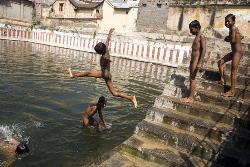Do u know Swimming???
@riteshsanodiya (455)
India
12 responses
@riteshsanodiya (455)
• India
13 Nov 06
i found something ,,,
The human body is composed primarily of water, and thus has a very similar density to water. Roughly, 70% of the body is water; while the lungs are filled with the air, the body is slightly less dense than the surrounding water, which exerts a buoyant force on it. Thus staying afloat requires only a slight propelling of water downward relative to the body, and transverse motion only a slight propelling of water in a direction opposite to the direction of intended motion. This propelling is accomplished by using the hands and forearms as paddles, and by kicking the legs to push water away from the body (though kicking accounts for relatively little overall).
A number of swimming styles have been developed based on the implementation of some or all of the following principles:
The torso and the legs should be kept as parallel as possible to the surface of the water. Dropped legs or a slanted torso dramatically increase drag. The hand should be extended forward of the head as much as possible. This increases the average length at the water-line, substantially increasing speed.
The time spent on the side should be maximized because the torso is narrower front-to-back than side-to-side on most swimmers. This reduces the frontal cross-section, reducing drag further, and also increasing the ratio between the body's water-line-length and width. Similar improvements are possible by orienting the narrowest direction of head, hands, legs and arms into the water. The torso is by far the most critical. The motion of the hand, arm, and leg from the back to the front should be in the air for as much as possible, and in the water, oriented as perfectly as possible, because the returning appendage has to move at least twice as fast as the swimmer, and in the water generates eight times the drag (which increases with the cube of the speed) of an equal amount of torso frontal area.
The basic "catch" of the water is not nearly as critical as the above items. Most swimmers simply grab water with their hand flat, or the fingers slightly spread, and then draw it smoothly down their body. None of the above techniques require improved strength. With strength training, the hands and feet can be extended further into the water, gaining more propulsion. For beginners, increased strength brings only small improvements if the above strategies (minimising drag and lengthening water-line) are not optimal.
@maddog108 (3435)
• Australia
13 Nov 06
go to a beach or river walk in the water dont go out to far making sure you can still stand and swim into shore over and over after a while you will get better at it then swim longer ps if you drown dont blame me lol
@maddog108 (3435)
• Australia
13 Nov 06
no worries but its best if you take someone with you that can swim if you get into trouble they can help you i have taught a lot of people to swim this way and there fine
@riteshsanodiya (455)
• India
13 Nov 06
The human body is composed primarily of water, and thus has a very similar density to water. Roughly, 70% of the body is water; while the lungs are filled with the air, the body is slightly less dense than the surrounding water, which exerts a buoyant force on it. Thus staying afloat requires only a slight propelling of water downward relative to the body, and transverse motion only a slight propelling of water in a direction opposite to the direction of intended motion. This propelling is accomplished by using the hands and forearms as paddles, and by kicking the legs to push water away from the body (though kicking accounts for relatively little overall).
A number of swimming styles have been developed based on the implementation of some or all of the following principles:
The torso and the legs should be kept as parallel as possible to the surface of the water. Dropped legs or a slanted torso dramatically increase drag. The hand should be extended forward of the head as much as possible. This increases the average length at the water-line, substantially increasing speed.
The time spent on the side should be maximized because the torso is narrower front-to-back than side-to-side on most swimmers. This reduces the frontal cross-section, reducing drag further, and also increasing the ratio between the body's water-line-length and width. Similar improvements are possible by orienting the narrowest direction of head, hands, legs and arms into the water. The torso is by far the most critical. The motion of the hand, arm, and leg from the back to the front should be in the air for as much as possible, and in the water, oriented as perfectly as possible, because the returning appendage has to move at least twice as fast as the swimmer, and in the water generates eight times the drag (which increases with the cube of the speed) of an equal amount of torso frontal area.
The basic "catch" of the water is not nearly as critical as the above items. Most swimmers simply grab water with their hand flat, or the fingers slightly spread, and then draw it smoothly down their body. None of the above techniques require improved strength. With strength training, the hands and feet can be extended further into the water, gaining more propulsion. For beginners, increased strength brings only small improvements if the above strategies (minimising drag and lengthening water-line) are not optimal.
@alladisada (2305)
• India
13 Nov 06
go to a swimming pool and instructos will teach you how to swim . once you learn, you really enjoy it
it is good excercise for the whole body
@windykite (62)
• China
13 Nov 06
yes,from 6 year old,I have learned swimming .the key to the success is throwing out frighten















